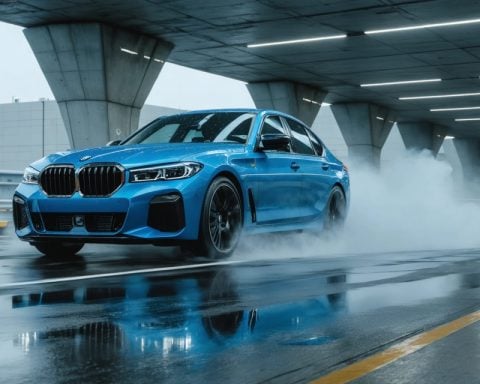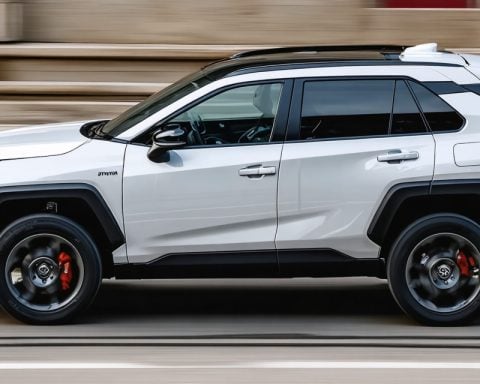At the Consumer Electronics Show in Las Vegas, BMW introduced its groundbreaking ‘Neue Klasse’ platform, a forward-thinking approach to driving technology. The company emphasizes that stringent CO2 regulations are pushing the automotive industry toward electrification, but the transition is taking longer than initially anticipated.
Stephen Durach from BMW discussed the platform’s new features, highlighting a shift away from conventional dashboards. Instead, the ‘Neue Klasse’ opts for 3D heads-up displays that extend across the entire windscreen, promoting an immersive driving experience. The design philosophy intentionally avoids cluttering the vehicle with large screens, which can be distracting to drivers.
As Europe grapples with the future of electric vehicles, questions loom about whether the sector can regain its momentum to meet official sales targets set for the next five to ten years. BMW’s investment in innovative technology aims to play a crucial role in this transition, potentially reshaping the landscape of electric mobility.
While the automotive industry faces numerous challenges, BMW’s latest advancements reflect a commitment to pushing boundaries and aligning with regulatory demands. The ‘Neue Klasse’ could be a significant step forward as car manufacturers navigate the complex road toward widespread electrification.
Revolutionizing Mobility: The Broader Implications of BMW’s ‘Neue Klasse’
The unveiling of BMW’s ‘Neue Klasse’ platform at the Consumer Electronics Show signals not just a leap in automotive technology but also an important shift in societal and cultural perceptions of mobility. As countries worldwide grapple with climate change and sustainability, the automotive industry’s pivot towards electrification carries profound implications for how society engages with transportation.
The move towards electric vehicles (EVs) reflects a fundamental change in consumer expectations and behavior. With a growing awareness of environmental issues, more car buyers are leaning towards sustainable alternatives. This shift is not just about personal preference; it reflects a broader cultural commitment to reducing carbon footprints, encouraging businesses and consumers alike to prioritize eco-friendly practices. The integration of advanced features like 3D heads-up displays also signifies a change in how drivers interact with their vehicles, suggesting a transformation in lifestyle that embraces technology while still emphasizing safety and practicality.
The global economy is inevitably influenced by this transition towards electrification. As automakers invest billions in new technology platforms such as BMW’s ‘Neue Klasse’, there is potential for significant job creation in sectors related to EV production, battery manufacturing, and sustainable materials. Regions that effectively engage in this shift may find themselves at the forefront of economic growth, emerging as leaders in both innovation and sustainability.
However, the environmental implications cannot be overlooked. While the move towards EVs promises reduced emissions from tailpipes, it is critical to address the entire lifecycle of electric vehicle production. This includes sourcing materials for batteries and the future of recycling these components to minimize waste. As nations commit to stricter CO2 regulations and set ambitious sales targets for electric mobility, manufacturers must balance innovation with sustainability to ensure a truly eco-friendly evolution.
Looking ahead, the future trends signaled by BMW’s ‘Neue Klasse’ indicate that the automotive landscape will continue to evolve rapidly. Emerging technologies such as autonomous driving, smart connectivity, and AI-driven functionalities in vehicles can create a more interconnected transportation ecosystem. This could lead to the optimization of urban mobility, reduced traffic congestion, and smarter resource allocation in congested cities.
Ultimately, BMW’s commitment to the ‘Neue Klasse’ platform may be more than a technological innovation; it could represent a pivotal moment in how we envision the future of mobility. As the industry continues to adapt to regulatory pressures and consumer demands, the long-term significance of platforms like the ‘Neue Klasse’ could redefine our relationship with automobiles, progress toward a more sustainable future, and establish new standards in an ever-evolving global economy.
Revolutionizing Mobility: Insights into BMW’s Neue Klasse Platform
The unveiling of BMW’s ‘Neue Klasse’ at CES marks a pivotal moment for the automotive industry. As electrification becomes imperative due to tightening CO2 regulations, this platform showcases innovative features that aim to redefine the driving experience. Below, we explore essential aspects of the Neue Klasse, including FAQs, pros and cons, and additional industry insights.
FAQs About BMW’s Neue Klasse
What is the Neue Klasse platform?
The Neue Klasse is BMW’s new vehicle architecture focusing on electric mobility. It aims to integrate advanced technology while enhancing driving pleasure.
How does the Neue Klasse differ from traditional vehicle designs?
Unlike conventional designs that feature multiple screens, the Neue Klasse utilizes a 3D heads-up display that spans the windscreen, minimizing distractions and promoting a more immersive experience.
When can consumers expect to see vehicles using the Neue Klasse?
While specific models and launch dates have not been finalized, BMW is expected to introduce vehicles built on this platform in the coming years, with the goal of meeting future sales targets.
Pros and Cons of the Neue Klasse
Pros:
– Innovative Display Technology: The 3D heads-up display provides a futuristic interface, enhancing visibility and reducing driver distraction.
– Sustainability Focus: With a clear commitment to electrification, BMW’s Neue Klasse aligns with global sustainability goals, promoting electric vehicle adoption.
– Potential for Enhanced Performance: The platform is designed to accommodate future advancements in battery and motor technology, ensuring better performance and range.
Cons:
– Transition Challenges: As the industry shifts toward electrification, companies including BMW may face hurdles in production and supply chain adjustments.
– Market Readiness: The broader market may not be fully prepared for such radical changes in vehicle design and interface, which could affect consumer acceptance.
Predictions for the Future of Electric Mobility
As major automotive players like BMW innovate with platforms like the Neue Klasse, the industry is likely to witness a few key trends over the next decade:
1. Increased Collaboration: Expect to see more partnerships across the tech and automotive sectors, as companies seek to enhance the technological underpinnings of electric vehicles.
2. Regulatory Impact: Stricter emissions regulations will likely accelerate developments in electrification, pushing more manufacturers to adopt similar platforms that emphasize sustainability.
3. Consumer Education Needs: As new technologies emerge, there will be a strong push for educating consumers on the benefits and functionalities of advanced systems like the Neue Klasse, paving the way for smoother adoption.
Quick Tips for Consumers Considering Electric Vehicles
– Research Your Options: Understand the different models available and what innovative technologies they offer. Look for features that enhance safety and driving experience.
– Consider Charging Infrastructure: Assess the availability of charging stations in your area, as ease of recharging remains a crucial factor in the transition to electric vehicles.
– Stay Informed on Market Trends: Follow automotive news to stay updated on advancements in electric mobility, battery technology, and governmental incentives that might affect your decision.
In conclusion, BMW’s Neue Klasse represents a significant leap forward in automotive design, influenced by evolving regulatory landscapes and consumer preferences. As the industry adjusts, staying informed and engaged with these changes will be key for prospective electric vehicle owners. For more insights on upcoming electric vehicle trends, you can visit Autoweek.













